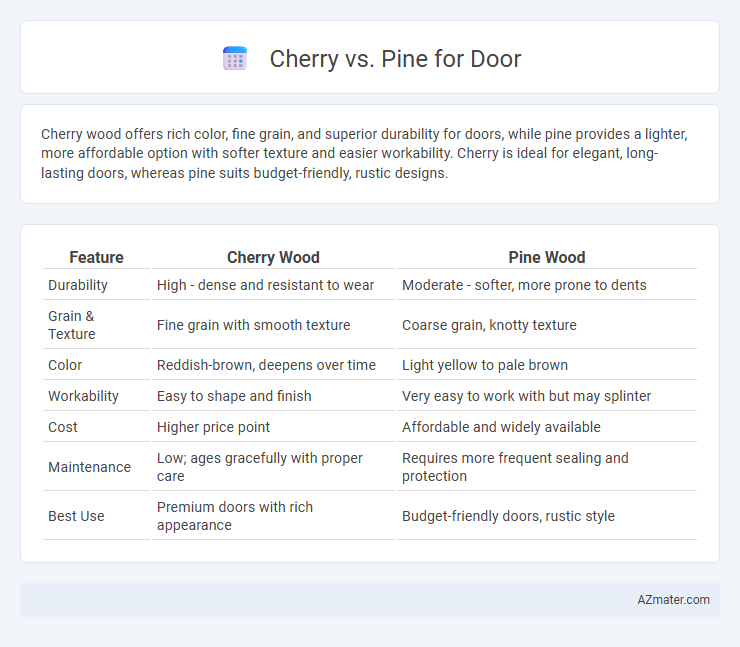Cherry wood offers rich color, fine grain, and superior durability for doors, while pine provides a lighter, more affordable option with softer texture and easier workability. Cherry is ideal for elegant, long-lasting doors, whereas pine suits budget-friendly, rustic designs.
Table of Comparison
| Feature | Cherry Wood | Pine Wood |
|---|---|---|
| Durability | High - dense and resistant to wear | Moderate - softer, more prone to dents |
| Grain & Texture | Fine grain with smooth texture | Coarse grain, knotty texture |
| Color | Reddish-brown, deepens over time | Light yellow to pale brown |
| Workability | Easy to shape and finish | Very easy to work with but may splinter |
| Cost | Higher price point | Affordable and widely available |
| Maintenance | Low; ages gracefully with proper care | Requires more frequent sealing and protection |
| Best Use | Premium doors with rich appearance | Budget-friendly doors, rustic style |
Introduction: Comparing Cherry and Pine for Doors
Cherry and pine are popular wood choices for doors, each offering distinct aesthetic and functional benefits. Cherry wood provides rich, warm tones and naturally darkens with age, enhancing its elegance and durability. Pine is lighter, more affordable, and features a rustic charm with visible knots, making it ideal for casual or country-style interiors.
Wood Characteristics: Cherry vs Pine
Cherry wood features a rich, reddish-brown hue that deepens with age, offering a smooth, fine grain and excellent durability for doors. Pine wood is lighter in color, ranging from creamy white to pale yellow, with a more pronounced grain pattern and softer texture that makes it more prone to dents and scratches. Cherry provides superior hardness and resistance to wear, while pine is more affordable and easier to work with but less durable in high-traffic or exterior door applications.
Appearance and Color Variation
Cherry wood for doors showcases a rich, reddish-brown hue that deepens and develops a warm patina over time, providing a luxurious and elegant appearance. Pine doors typically feature a lighter, creamy-yellow color with prominent grain patterns and knots, offering a rustic and natural look. The color variation in Cherry is more subtle and uniform, while Pine exhibits greater contrast and character through its distinct knots and streaks.
Durability and Strength Comparison
Cherry wood offers a balanced combination of moderate hardness and good durability, making it suitable for interior doors that require a smooth finish and resistance to wear. Pine is generally softer and less dense, which can lead to dents and scratches over time, making it less ideal for high-traffic areas but more affordable and easier to work with. When prioritizing durability and strength in door construction, cherry wood outperforms pine due to its higher Janka hardness rating and better impact resistance.
Workability and Ease of Installation
Cherry wood offers excellent workability due to its fine, straight grain and smooth texture, allowing for precise cuts and detailed carvings ideal for custom door designs. Pine is softer and lighter, making it easier to cut and handle but more prone to dents and scratches during installation. Both woods facilitate straightforward installation, but Pine's lightweight nature can simplify handling, while Cherry provides a sturdier, more durable finish with less risk of damage on site.
Cost and Affordability
Cherry doors typically cost more than pine due to the wood's dense grain and rich color, which provide a luxurious and durable finish. Pine doors are more affordable, making them a popular choice for budget-conscious projects, but they may require more maintenance over time. Choosing between cherry and pine depends largely on initial investment tolerance and long-term durability preferences.
Maintenance Requirements
Cherry doors require moderate maintenance, including regular cleaning and occasional refinishing to maintain their rich, warm color and prevent surface scratches. Pine doors demand more frequent upkeep due to their softer grain, often needing resealing or repainting to protect against dents, moisture, and warping. Both woods benefit from humidity control and protective coatings to extend durability and preserve aesthetic appeal.
Environmental Impact and Sustainability
Cherry wood, sourced from responsibly managed hardwood forests, offers moderate environmental benefits due to its slower growth rate and higher carbon sequestration compared to fast-growing species. Pine, typically harvested from sustainably managed softwood plantations, has a lower environmental impact owing to its rapid growth and efficient regeneration. Both woods can be eco-friendly choices when certified by organizations like FSC, emphasizing sustainable forestry practices and reduced habitat disruption.
Best Uses and Applications for Doors
Cherry wood offers a smooth grain and rich reddish-brown color, making it ideal for high-end interior doors where aesthetics and fine craftsmanship are prioritized. Pine is a softer, more affordable wood with a lighter color, perfect for painted doors or budget-friendly projects that require easy customization. Both materials excel in different applications, with cherry suited for elegant, solid wood doors and pine favored for rustic, casual, or primed and painted door designs.
Conclusion: Which Wood is Better for Your Door?
Cherry wood offers rich color and smooth grain, providing an elegant and durable door surface ideal for interior use. Pine is more affordable and lightweight, with a rustic appearance suitable for budget-friendly or exterior doors but may require more maintenance due to its softness. Choosing between cherry and pine depends on your priorities for aesthetics, durability, and budget, with cherry favored for long-lasting luxury and pine preferred for cost-effective versatility.

Infographic: Cherry vs Pine for Door
 azmater.com
azmater.com